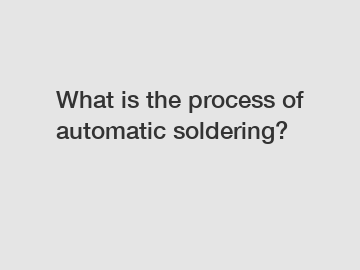What is the process of automatic soldering?
Soldering plays a crucial role in the manufacturing industry, especially when it comes to electronic components. It ensures strong and reliable connections between various parts, making sure that devices function as intended. In recent years, automatic soldering has gained popularity due to its efficiency and precision. Today, we delve into the fascinating process of automatic soldering.
Automatic soldering is a method that utilizes specialized machinery to apply solder to electronic components without the need for human intervention. This process offers numerous advantages over traditional manual soldering, such as increased productivity, consistency, and reduced labor costs. Let's explore the detailed steps involved in this highly efficient process.
Step 1: Preparation.

Before the automatic soldering process begins, proper preparation is essential. This entails precisely positioning the components that require soldering. Advanced machinery is utilized to ensure components are aligned accurately, even in high-volume production scenarios.
Step 2: Flux Application.
Flux is a vital component in the automatic soldering process as it aids in achieving a reliable and strong bond between the components. Flux application is done using specialized equipment, which applies a precise amount to the designated areas. Flux helps remove any oxidation or impurities, ensuring a clean surface for soldering.
Step 3: Preheating.
Preheating is a critical step in automatic soldering as it helps activate the flux and improve the solder's wetting properties. Components are carefully heated to a specific temperature to optimize the soldering process and achieve consistent results.
Step 4: Solder Application.
Automatic soldering machines employ various techniques to apply solder accurately. One commonly used method is the use of wave soldering, where components are passed over a wave of molten solder. This ensures that all necessary connections are coated evenly and uniformly.
Another method is selective soldering, which allows for precise application of solder to specific areas or components. This technique is particularly useful in intricate or densely populated PCBs (Printed Circuit Boards).
Step 5: Cooling and Inspection.
Once solder has been applied to the components, they are allowed to cool down. Cooling is crucial to ensure the stability and solidification of the solder joints. After cooling, an inspection process takes place to verify the quality of the solder joints. Automated systems use high-resolution cameras and algorithms to detect any anomalies or defects. This ensures compliance with the highest quality standards.
Step 6: Cleaning and Finishing.
To guarantee long-lasting performance, it is imperative to remove any excess flux or residue from the soldering process. Automatic soldering machines often incorporate cleaning mechanisms to eliminate these impurities. Cleaning techniques may include solvent washing, ultrasonic cleaning, or high-pressure water jets. This step finalizes the soldering process, leaving components ready for further assembly or testing.
Automatic soldering is a complex and intricate process that requires the integration of advanced technology and machinery. Manufacturers invest heavily in these automated systems to ensure high precision, efficiency, and reliability in their assembly lines. By eliminating the reliance on human operators, these machines reduce the risk of human errors and inconsistencies, resulting in higher productivity and cost savings.
Moreover, automatic soldering machines offer the benefit of scalability. With the ability to handle large volumes of components, manufacturers can meet increasing market demands swiftly and efficiently. This scalability allows for greater flexibility in production planning and helps keep up with ever-changing technological advancements.
In conclusion, the process of automatic soldering is a remarkable feat of engineering, combining high-tech machinery, impeccable precision, and reliance on automation. Its ability to consistently produce quality solder joints, increase productivity, and reduce costs make it an integral part of the manufacturing industry. As technology continues to advance, the future of automatic soldering looks bright, promising even greater efficiency and enhanced capabilities.
Are you interested in learning more about Desktop Dispensing Robot supplier, Automatic Soldering robot, hot melt dispensing? Contact us today to secure an expert consultation!

Comments
0